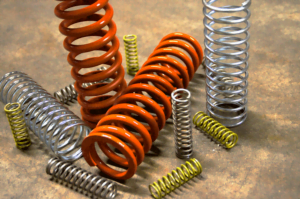When you hear the word “spring,” it is likely that the image of a compression spring comes to mind. Compression springs are the most common of all spring types.
As the name suggests, compression springs are designed to compress when force is applied. These springs deflect in a linear motion, resisting the applied force and storing energy.
Common Applications for Compression Springs

Compression springs are frequently used in industrial equipment as well as in many household objects. Applications for these versatile springs include:
- Automotive shocks
- Flow control valves
- Medical devices
- Military equipment
- Firearms
- Pens
Important Considerations When Designing Compression Springs
As with all custom springs, it is important to consider several factors when designing compression springs.
1. Selecting the right-sized spring for your space prevents spring failure
If a compression spring is the wrong length for the space for which it is designed, it will not be able to travel far enough to function properly, or may not be able to compress as much as needed.
Of course the spring must also physically fit in the space provided, with an inner diameter large enough if fitting over a rod, or an outer diameter small e
nough if fitting inside a hole.
2. Overstressing a spring will make it more likely to fail
Although compression springs can withstand stress better than other spring types (e.g., extension springs), excess stress can still cause spring failure.
An overstressed compression spring may yield, or leave its elastic range, leading to permanent spring deflection. Repeated compression of an overstressed spring can lead to fatigue failure.
3. Wire diameter, outer diameter, and space between coils play important roles in limiting spring stress
Here are a few rules to remember regarding spring stress. Each rule assumes all other dimensions are constant.
- The larger the wire diameter of a compression spring, the more stress will be placed on the spring.
- The larger the outer diameter, the less stress will be placed on the spring.
- The more space there is between the spring coils, the more stress will be placed on the spring.
Calibrating these three measurements for your application is key to getting your design right.
4. Ground ends create a more precise fit for compression springs
How flush does your spring’s alignment need to be? For certain applications, such as firearms and flow control valves, ground ends may be necessary.
If your spring has a tight index (the ratio of the mean coil diameter to the diameter of the wire), that is a good indication that you may need to call out ground ends.
5. Secondary processes must be managed carefully
Does your compression spring require secondary processes such as shot peening, plating, or powder coating? Certain finishing treatments can introduce risk.
For example, when springs require plating, we almost always recommend a baking process afterward to help prevent hydrogen embrittlement.
6. Designing tight tolerances will increase manufacturing costs
It is important to be aware that calling out tight tolerances for your springs will likely increase your manufacturing costs.
If you are unsure how tight your tolerances need to be, we are happy to provide you with either the standard commercial or precision spring tolerances for compression springs.
Choose Gifford Spring Company as Your Custom Compression Spring Manufacturer
At Gifford Spring Company, we typically conduct a round of prototyping when working on a new compression spring design. In this phase, we test a specific set of variables for the custom spring: material, wire diameter, outer diameter, and space between coils. Prototyping helps us make sure that a spring functions as intended before we move into production.
In our shop, we believe that proactive communication with our customers always leads to the best results.
Request a quote to begin collaborating on your custom spring today!